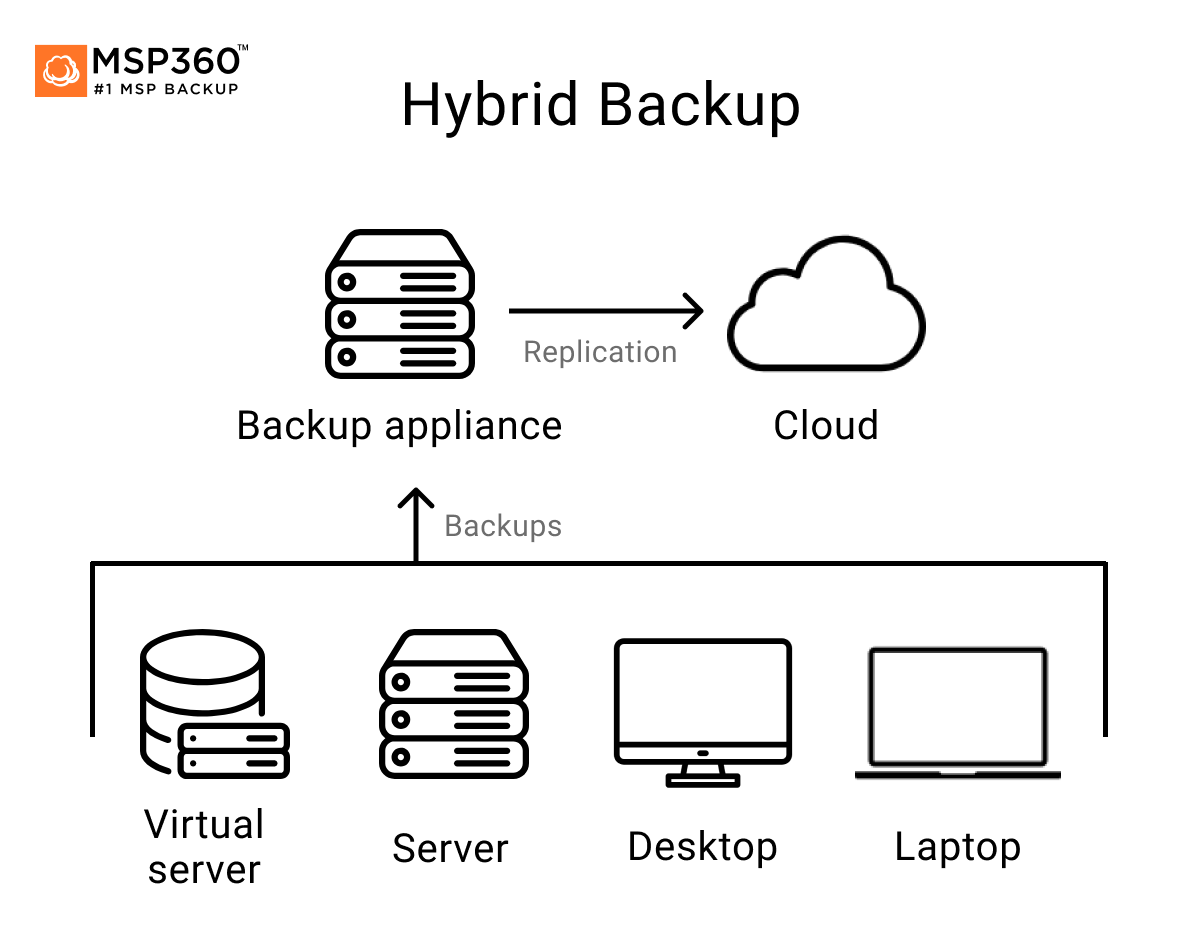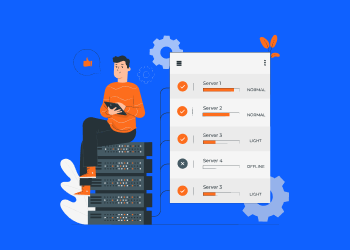Let’s face it. Although only about 17% of businesses lack data backups, the truth of the matter is, they are not the only ones at risk. It turns out that quite a huge fraction of backed-up organizations are still running poorly optimized backup solutions.
For instance, 60% of backup instances end up with incomplete data. Hence, I guess it’s no surprise that at least half of data recovery attempts are unsuccessful.
Well, you could blame an array of things. But, all things considered, we can agree that such mishaps affect both local backups and cloud backups.
Local Backup vs Cloud Backup vs Hybrid Cloud Backup
Local, for starters, has been the traditional backup strategy for ages now, and it continues to attract a considerable number of businesses. They leverage it for the unlimited control privileges it offers, plus high-speed data transfer.
However, while all these benefits are fairly remarkable, the most popular kid on the block is cloud backup. This is where you’ll find 93% of small businesses, 82% of mid-sized businesses, as well as 81% of large enterprises.
Cloud backup continues to win them over, thanks to its flexibility, affordability, remote data access, user-friendliness, and unlimited storage.
Sadly, though, each of these strategies has its fair share of weaknesses. Local backups are exceedingly risky and costly, while cloud backup offers restricted control privileges.
Now, because of these limitations, businesses ultimately saw the need to approach things differently. And so, the hybrid cloud backup strategy was developed to offer a perfect blend of both worlds. Instead of restricting you to just local storage or cloud infrastructure, this type of backup comes with a cocktail that features both local and cloud backup.
And how has this impacted businesses?
Read on to find out the answers to that, along with any other query you might have. This guide digs deeper into the whole issue to reveal what hybrid cloud backup really entails, as well as the privileges that come with it.

What is Hybrid Cloud Backup and How Does it Work?
In simple terms, this is basically a fusion of both worlds: local backups and cloud-based data backup. Remote cloud servers are systematically linked and synced with local backup resources to offer off-premise recovery points in the event of a disaster.

You could, for instance, set up a system that backs up your data to network-attached storage (NAS) devices in the company’s locally shared network - then subsequently proceeds to create copies in the cloud automatically.
As such, the local storage acts as the primary on-premise backup, while cloud servers provide additional protection as secondary off-premise backups. This means that, in the event of a disaster, hybrid cloud backup gives you something to fall back on if the local backups happen to fail.
But, that’s not all. There are many other benefits. Here’s a breakdown of some of the most notable ones:
Benefits of Hybrid Cloud Backup
- Reduces hardware costs: It’s no secret that NAS devices and servers don’t come cheap. Setting up and maintaining local backups is a costly affair. And the worst bit is, the hardware costs keep rising as your data grows and backup needs increase. With a hybrid cloud backup system, however, you could easily scale up your cloud resources to accommodate more data. Cloud backup providers usually offer such capabilities at a fraction of the cost of upgrading local storage infrastructure.
- Offers dynamic data control: There is a range of flexible management controls that allow you to choose where and how you’d like to back up various types of data. You could, for instance, isolate sensitive documents and keep them in your local network - then, in the meantime, upload customer-facing applications to the cloud.
- Boosts your backup and recovery speeds: With hybrid cloud backup, you get to keep your mission-critical data close within the company’s local network, while secondary, less-critical data is held in the cloud. Therefore, in the event of a disaster, you should be able to conveniently recover essential data directly through the local high-speed network.
- Ensures business continuity: While the local section fundamentally acts as the primary restore point for mission-critical data, the corresponding cloud servers are best suited for remote, long-term storage. And with that comes business continuity. You can easily keep your company info in the cloud for years.
- Mitigates Internet speed restrictions: Although cloud backups can be accessed remotely, you may not be able to restore the files as fast as you may wish, since the download capabilities depend on your Internet speeds. Hybrid cloud backup mitigates this problem by supplementing cloud storage with high-speed local backups.
- Enhances data security: It’s common knowledge that data security threats overwhelmingly emanate from local vulnerabilities, such as endpoint devices. A breach on one of your user devices could quickly spread through the network, attacking even your local NAS backups. This backup type tries to avoid such scenarios by isolating and keeping secondary versions off-premise in remote servers, away from locally shared networks.
- Leverages multiple cloud services: Hybrid cloud backup doesn’t necessarily limit you to a single cloud service provider. You can go ahead and use various cloud storage providers, and then integrate them to form one streamlined backup framework.
- Simplifies compliance: Complying with statutory data regulations and standards is much easier. You could, for instance, retain sensitive private data within your local storage, while the rest goes to the cloud. And if your local network lacks the required encryption tools, at least this option gives you the benefit of bringing in a compliant cloud service. You can work hand-in-hand with cloud providers who possess compliance certifications for GDPR, PCI, SOX, and HIPAA.
- Improves redundancy: The biggest benefit of hybrid cloud backup is enhanced redundancy. With two backups to fall back on in the event of a disaster, you’re almost assured of full recovery. If the local backups happen to fail midway, at least you can always switch to your secondary cloud backup copies. Hence, hybrid approach can be said to be a foolproof system for protecting business data.
MSP 360 related articles and resources
Extend your know-how around MSP360 backup software and data protection. To effectively leverage cloud services like Microsoft 365 and Google Workspace, businesses and Managed Service Providers (MSPs) must navigate a variety of strategic, security, and operational considerations. For MSPs looking to expand their offerings, selling Microsoft 365 provides a robust framework for delivering value to clients. Understanding the Microsoft 365 shared responsibility model is critical for delineating responsibilities between providers and clients to ensure data security and compliance. When choosing email solutions, comparing Exchange Online vs. Exchange On-Premises can guide decisions based on scalability and maintenance needs. For organizations transitioning to Microsoft 365, resources on migrating from Gmail to Office 365 offer step-by-step guidance. To safeguard data, adopting Microsoft 365 best practices for data protection is essential, particularly for cloud-based environments. When evaluating cloud storage, a comparison of Dropbox, OneDrive for Business, and Google G Suite highlights key differences in functionality and integration. For comprehensive backup solutions, tools like MSP360 Backup for M365 and Google Workspace provide robust options, including PST export capabilities. Additionally, securing Google Workspace requires adherence to a Google G Suite security guide, while Office 365 SharePoint backup and Office 365 mailbox backup strategies ensure data resilience across critical workloads.
Conclusion: How MSP360 Helps Your Hybrid Backup Needs
Assuming that you’re already running a solid local backup system, the other thing you’ll need in order to implement hybrid cloud backup in your organization is, of course, a robust cloud backup service.
But that’s not all. You still need an engine for integrating the two systems, managing your data, and, most importantly, powering your entire backup framework.
Now, that’s where MSP360 truly shines. Our award-winning remote backup solution is designed to automate the backup and recovery of all types of system data - including applications and operating systems. It’s capable of handling not only Windows desktop backup and server backup, but also Linux, macOS, Hyper-V, VMware, Microsoft Exchange, plus Microsoft SQL Server.
Most importantly, though, MSP360 is seamlessly compatible with all major cloud storage providers - Backblaze B2, Wasabi, Microsoft Azure, Google Cloud Platform, Amazon S3, Amazon Glacier, and so much more.






